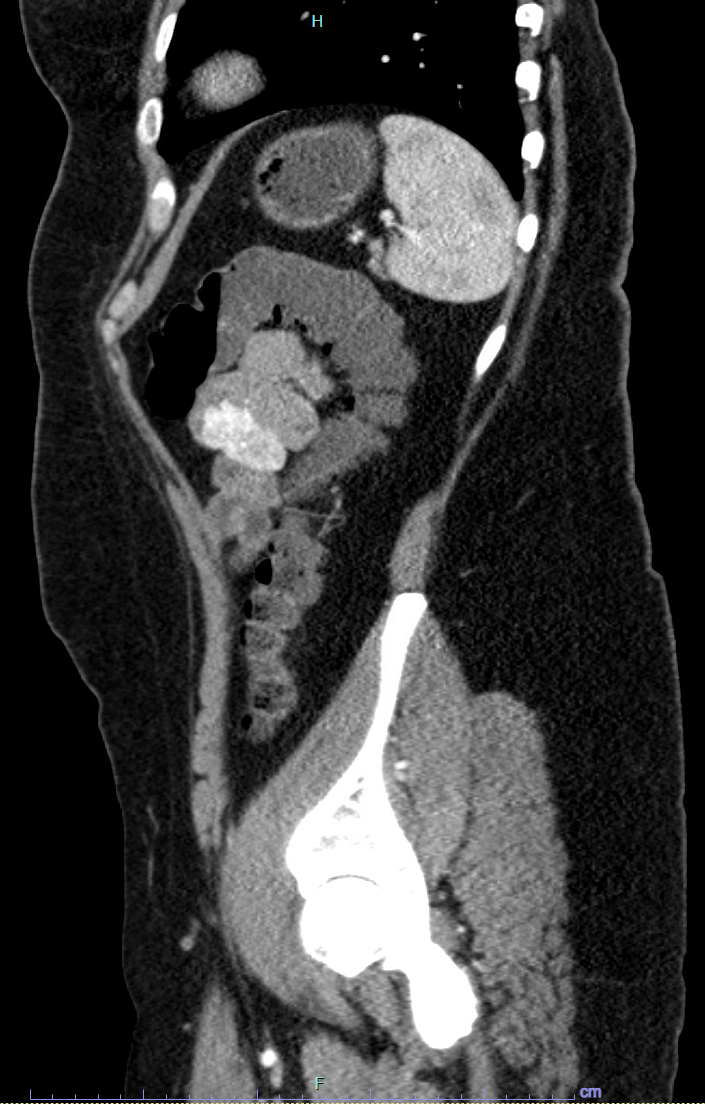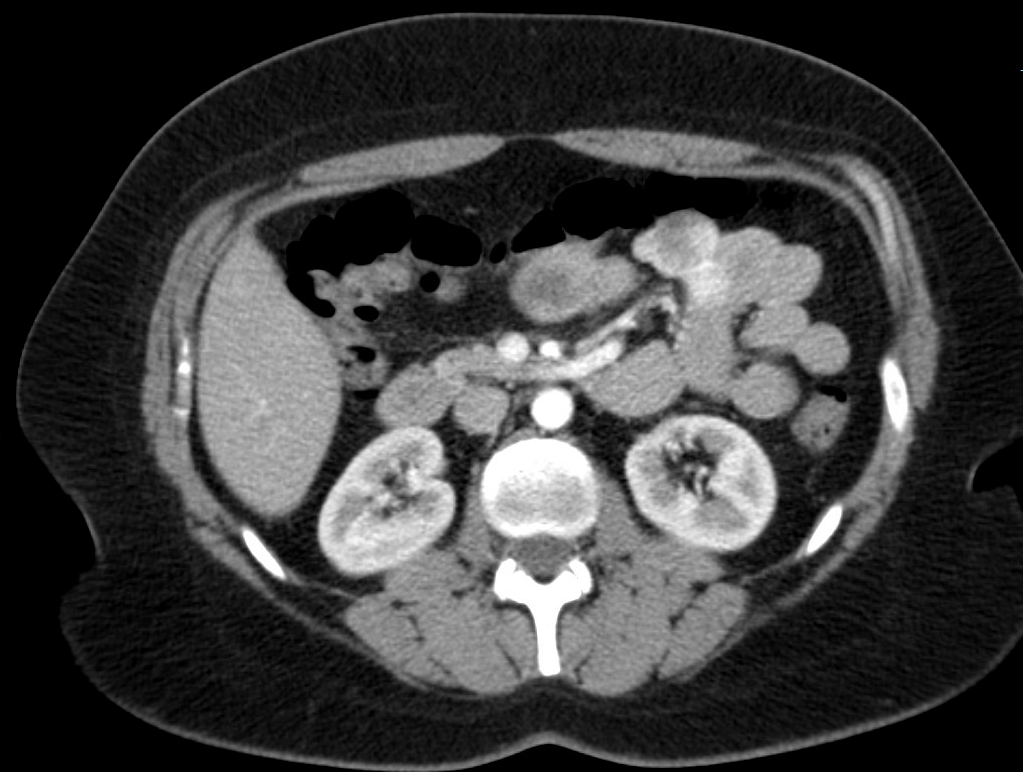Monday Poster Session
Category: Small Intestine
P4101 - GIST of the Problem: From One Diagnosis to Another -- Uncovering Jejunal Gastrointestinal Stromal Tumor (GIST) in a Young Female During Endometriosis Work-Up
Monday, October 27, 2025
10:30 AM - 4:00 PM PDT
Location: Exhibit Hall

Riddhi Machchhar, DO (she/her/hers)
Hackensack Meridian OUMC
Brick, NJ
Presenting Author(s)
Riddhi Machchhar, DO1, Ana Torres Hernandez, BS2, Vera Hapshy, DO3, Hasrshvardhan Sanekommu, MD3, Assif Rozovsky, MD1
1Hackensack Meridian OUMC, Brick, NJ; 2Rowan University School of Osteopathic Medicine, Stratford, NJ; 3Hackensack Meridian JSUMC, Neptune City, NJ
Introduction: Gastrointestinal stromal tumors (GISTs) are rare mesenchymal tumors predominantly seen in older patients. Our case presents a 34-year-old female diagnosed with a jejunal GIST during an endometriosis workup. Initially misdiagnosed due to cyclical abdominal pain & bleeding, advanced imaging prior to gynecologic surgery revealed the tumor, leading to successful intervention and ongoing treatment.
Case Description/
Methods: A 34-year-old female with history of recurrent melena was hospitalized due to symptomatic anemia and low hemoglobin levels, having experienced weakness, dizziness, and black tarry stools. Her hemoglobin had dropped from 11 to 8.9 g/dL. For three years, she had intermittent melena, mainly during menstruation. Despite evaluations by multiple gastroenterologists, including several endoscopies and colonoscopies, no source of bleeding was found. Given the cyclic nature of her symptoms, she was referred to an endometriosis specialist. An MRI suggested deep infiltrative endometriosis but no endometrioma. During further evaluation, a CT angiography (CTA) revealed a left upper quadrant jejunal mass, suspected to be a carcinoid tumor or GIST. A diagnostic laparoscopy, including removal of the mass, confirmed a jejunal GIST of spindle cell type origin. The patient is in follow-up with hematology/oncology and has started chemotherapy. Her family history includes malignancies, but genetic testing was negative for hereditary cancer syndromes.
Discussion: GISTs are the most prevalent mesenchymal tumors in the GI tract, primarily affecting individuals over the age of 50. This case illustrates a unique instance of a young female patient presenting with symptomatic anemia. Although GISTs can cause GI bleeding, her anemia was initially misdiagnosed as endometriosis based on MRI results, delaying the identification of the jejunal mass. A subsequent CT angiography successfully revealed the mass, confirmed as a jejunal GIST—an uncommon location for these tumors.
GISTs arise from interstitial cells of Cajal and are frequently linked to mutations in the KIT gene or PDGFRA. Immunohistochemical staining using markers like KIT and DOG1 is crucial for diagnosis. The patient was diagnosed with a spindle cell type GIST, which constitutes about 70% of cases. The preferred treatment for non-metastatic GIST is complete surgical resection. Nonetheless, small GISTs pose a risk of malignancy, necessitating careful postoperative monitoring and possibly the use of adjuvant therapy with imatinib to minimize recurrence.

Figure: Figure 2, CTA A/P - Calcified intramural and extramural enhancing jejunal mass (35 mm) suspicious for jejunal neoplasm.

Figure: Figure 2, CT Enterography - LUQ jejunal mass (2.4 x 4.0 x 2.9 cm). Represents a carcinoid tumor vs gastrointestinal stromal tumor (GIST)
Disclosures:
Riddhi Machchhar indicated no relevant financial relationships.
Ana Torres Hernandez indicated no relevant financial relationships.
Vera Hapshy indicated no relevant financial relationships.
Hasrshvardhan Sanekommu indicated no relevant financial relationships.
Assif Rozovsky indicated no relevant financial relationships.
Riddhi Machchhar, DO1, Ana Torres Hernandez, BS2, Vera Hapshy, DO3, Hasrshvardhan Sanekommu, MD3, Assif Rozovsky, MD1. P4101 - GIST of the Problem: From One Diagnosis to Another -- Uncovering Jejunal Gastrointestinal Stromal Tumor (GIST) in a Young Female During Endometriosis Work-Up, ACG 2025 Annual Scientific Meeting Abstracts. Phoenix, AZ: American College of Gastroenterology.
1Hackensack Meridian OUMC, Brick, NJ; 2Rowan University School of Osteopathic Medicine, Stratford, NJ; 3Hackensack Meridian JSUMC, Neptune City, NJ
Introduction: Gastrointestinal stromal tumors (GISTs) are rare mesenchymal tumors predominantly seen in older patients. Our case presents a 34-year-old female diagnosed with a jejunal GIST during an endometriosis workup. Initially misdiagnosed due to cyclical abdominal pain & bleeding, advanced imaging prior to gynecologic surgery revealed the tumor, leading to successful intervention and ongoing treatment.
Case Description/
Methods: A 34-year-old female with history of recurrent melena was hospitalized due to symptomatic anemia and low hemoglobin levels, having experienced weakness, dizziness, and black tarry stools. Her hemoglobin had dropped from 11 to 8.9 g/dL. For three years, she had intermittent melena, mainly during menstruation. Despite evaluations by multiple gastroenterologists, including several endoscopies and colonoscopies, no source of bleeding was found. Given the cyclic nature of her symptoms, she was referred to an endometriosis specialist. An MRI suggested deep infiltrative endometriosis but no endometrioma. During further evaluation, a CT angiography (CTA) revealed a left upper quadrant jejunal mass, suspected to be a carcinoid tumor or GIST. A diagnostic laparoscopy, including removal of the mass, confirmed a jejunal GIST of spindle cell type origin. The patient is in follow-up with hematology/oncology and has started chemotherapy. Her family history includes malignancies, but genetic testing was negative for hereditary cancer syndromes.
Discussion: GISTs are the most prevalent mesenchymal tumors in the GI tract, primarily affecting individuals over the age of 50. This case illustrates a unique instance of a young female patient presenting with symptomatic anemia. Although GISTs can cause GI bleeding, her anemia was initially misdiagnosed as endometriosis based on MRI results, delaying the identification of the jejunal mass. A subsequent CT angiography successfully revealed the mass, confirmed as a jejunal GIST—an uncommon location for these tumors.
GISTs arise from interstitial cells of Cajal and are frequently linked to mutations in the KIT gene or PDGFRA. Immunohistochemical staining using markers like KIT and DOG1 is crucial for diagnosis. The patient was diagnosed with a spindle cell type GIST, which constitutes about 70% of cases. The preferred treatment for non-metastatic GIST is complete surgical resection. Nonetheless, small GISTs pose a risk of malignancy, necessitating careful postoperative monitoring and possibly the use of adjuvant therapy with imatinib to minimize recurrence.

Figure: Figure 2, CTA A/P - Calcified intramural and extramural enhancing jejunal mass (35 mm) suspicious for jejunal neoplasm.

Figure: Figure 2, CT Enterography - LUQ jejunal mass (2.4 x 4.0 x 2.9 cm). Represents a carcinoid tumor vs gastrointestinal stromal tumor (GIST)
Disclosures:
Riddhi Machchhar indicated no relevant financial relationships.
Ana Torres Hernandez indicated no relevant financial relationships.
Vera Hapshy indicated no relevant financial relationships.
Hasrshvardhan Sanekommu indicated no relevant financial relationships.
Assif Rozovsky indicated no relevant financial relationships.
Riddhi Machchhar, DO1, Ana Torres Hernandez, BS2, Vera Hapshy, DO3, Hasrshvardhan Sanekommu, MD3, Assif Rozovsky, MD1. P4101 - GIST of the Problem: From One Diagnosis to Another -- Uncovering Jejunal Gastrointestinal Stromal Tumor (GIST) in a Young Female During Endometriosis Work-Up, ACG 2025 Annual Scientific Meeting Abstracts. Phoenix, AZ: American College of Gastroenterology.
